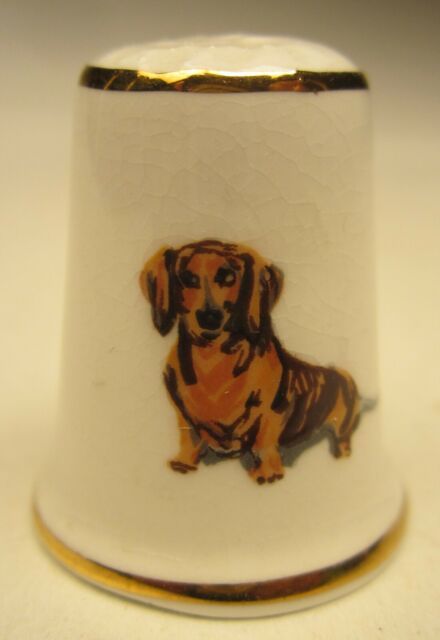
We suspect that sewing isn’t a skill that is passed along in families like it once was when it was more of a necessity, and less of a hobby. To that end, we suppose there are households in which one can’t find a thimble at all (that small pitted cup worn on the finger to protect fingers from pin pricks while sewing) unless there’s an old game of Monopoly* in the house. It’s probably even rarer these days to find someone under a certain age who collects thimbles, but we could be wrong.
The first thimble ever known dates back to the Han Dynasty in ancient China. It looked like a simple ring and was discovered during the Cultural Revolution of the People’s Republic of China in a lesser tomb in Jiangling. Archeological finds, however, suggest that thimbles may be older than that. Evidence was found to suggest that hunters fashioned crude thimbles to sew Wooly Mammoth leather.
Thimbles as we know them today are thought to have first made by a Dutch metal worker around 1695 in England. Back then, it was called a ” thumb-bell” because it was worn on the thumb and shaped like a bell.
While most of us see thimbles as a utilitarian item, they have had some interesting uses. At one time, they were used to measure spirits (as in alcohol – ever hear the phrase, “just a thimbleful?”). Starting in the 16th century, ladies were given silver thimbles as an ideal gift, and later, a different kind of lady, as in Ladies of the night, found them useful to tap on the window or door of a “client” to announce their arrival. Victorian schoolmistresses, too, found a new, if not a bit sadistic – use for thimbles: They rapped the top of the heads of disruptive students with thimbles. During WWI, hospitals needed to buy equipment, so silver thimbles were collected by those who had nothing else to give, and were melted down and used for money by the British government. Later on in the 1930’s to the 1940’s, the glass topped thimbles were used for advertising.
And you thought you knew thimbles.
These days, thimbles are usually made from metal, glass or china, and sometimes leather, rubber, or even wood, but the earliest ones were made from brass, bone, horn, or ivory. Some early thimble-makers “fancied up” thimbles with semi-precious stones, and/or decorated the outer rims, but someone in the 19th century thought silver would make a good thimble material. Wrong. Silver is soft, and it didn’t take long before that idea was ditched after too many thumbs had been pierced nearly through.
That said, people still wanted beautiful thimbles they could show off or even collect. The problem was solved by a jeweler named Charles Horner ((1837–1896). He “sandwiched” strong steel and sterling silver in layers formed separately, but stacked together. Then he formed a protruding lip of the inner silver liner that he burnished over the steel, essentially locking it into place in a groove around the outer silver decorative layer. These were called Dorcas thimbles, and after Horner died, his sons took over the business, built a factory in Halifax, and expanded the business to produce silverware, tableware and clocks.
Those Horner thimbles are highly collectable, but so are other old thimbles. A Meissen porcelain thimble, circa 1730, with a landscape scene painted on the band, sold for $20,000, and in 2014, a gold thimble, circa 1805, attributed to Paul Revere Jr., sold for $10,000 during an auction at Leslie Hindman Auctioneers.
And that takes us to “digitabulists,” the name for people who collect them. As you might imagine, just as there are people who collect particular types of postage stamps, vintage buttons, or anything else people like to collect, there are folks who narrow the field of thimble collecting down to specialties. Some people collect children’s thimbles, some gather only thimbles made of a certain material, and some collect dog thimbles. In fact, the first known example of a carved ivory thimble depicts a dog coursing after game, a common theme of the Renaissance period.
We simply lack the spaces to share all the photos of dog themed thimbles, but suffice it to say that a great many breeds have appeared on thimbles, and the more common the breed, the more apt one is to find them. A simple Google or Duck Duck Go search will yield results!
You can learn more about digitabulists and thimble collecting by reading, “Thimble Pleasures: An Interview With Sewing Collector Sue Gowan.”
**The thimble was the piece of choice of US Monopoly champion, Richard Marinaccio, one of the original pieces from 1935, but shockingly, it was voted out in 2017.
Image of a Dachshund thimble we found on-line that has since been sold.
